|
|
|
Sort Order |
|
|
|
Items / Page
|
|
|
|
|
|
|
| Srl | Item |
| 1 |
ID:
127160


|
|
|
|
|
| Publication |
2014.
|
| Summary/Abstract |
Among natural gas producing nations, there has been some concern about how the Asia Pacific will meet future demand for energy. We argue that natural gas, both regional and global, will play a vital role. Estimates of potential gas consumption in the region are analyzed and used to develop consensus projections to 2030. These consumption profiles are compared with gas supply estimates including indigenous, pipeline and LNG for the Asia Pacific market. From this analytical framework, we find that demand will be sufficiently large to accommodate supplies from diverse sources including North America, the Middle East, Central Asia, Russia, and the Asia Pacific itself. An important policy implication is that gas producing and consuming nations should benefit from promoting gas trade and not be concerned about a situation of potential lack of demand coupled with oversupply.
|
|
|
|
|
|
|
|
|
|
|
|
|
|
|
|
| 2 |
ID:
127211
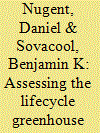

|
|
|
|
|
| Publication |
2014.
|
| Summary/Abstract |
This paper critically screens 153 lifecycle studies covering a broad range of wind and solar photovoltaic (PV) electricity generation technologies to identify 41 of the most relevant, recent, rigorous, original, and complete assessments so that the dynamics of their greenhouse gas (GHG) emissions profiles can be determined. When viewed in a holistic manner, including initial materials extraction, manufacturing, use and disposal/decommissioning, these 41 studies show that both wind and solar systems are directly tied to and responsible for GHG emissions. They are thus not actually emissions free technologies. Moreover, by spotlighting the lifecycle stages and physical characteristics of these technologies that are most responsible for emissions, improvements can be made to lower their carbon footprint. As such, through in-depth examination of the results of these studies and the variations therein, this article uncovers best practices in wind and solar design and deployment that can better inform climate change mitigation efforts in the electricity sector.
|
|
|
|
|
|
|
|
|
|
|
|
|
|
|
|
| 3 |
ID:
127283
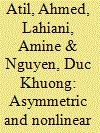

|
|
|
|
|
| Publication |
2014.
|
| Summary/Abstract |
In this article, we use the recently developed nonlinear autoregressive distributed lags (NARDL) model to examine the pass-through of crude oil prices into gasoline and natural gas prices. Our approach allows us to simultaneously test the short- and long-run nonlinearities through positive and negative partial sum decompositions of the predetermined explanatory variables. It also offers the possibility to quantify the respective responses of gasoline and natural gas prices to positive and negative oil price shocks from the asymmetric dynamic multipliers. The obtained results indicate that oil prices affect gasoline prices and natural gas prices in an asymmetric and nonlinear manner, but the price transmission mechanism is not the same. Important policy implications can be learned from the empirical findings.
|
|
|
|
|
|
|
|
|
|
|
|
|
|
|
|
| 4 |
ID:
127302
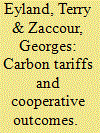

|
|
|
|
|
| Publication |
2014.
|
| Summary/Abstract |
In the absence of an international environmental agreement (IEA) on climate change, a country may be reluctant to unilaterally implement environmental actions, as this may lead to the relocation of firms to other, lax-on-pollution countries. To avoid this problem, while still taking care of the environment, a country may impose a carbon tariff that adjusts for the differences between its own carbon tax and the other country's tax. We consider two countries with a representative firm in each one, and characterize and contrast the equilibrium strategies and outcomes in three scenarios. In the first (benchmark) scenario, in a first stage the regulators in the two countries determine the carbon taxes noncooperatively, and in a second stage, the firms compete à la Cournot. In the second scenario, the regulators cooperate in determining the carbon taxes, while the firms still play a noncooperative Cournot game. In the third scenario, we add another player, e.g., the World Trade Organization, which announced a border tax in a prior stage; the game is then played as in the first scenario. Our two major results are (i) a border-tax adjustment (BTA) mimics quite well the cooperative solution in setting the carbon taxes as in scenario two. This means that a BTA may be a way around the lack of enthusiasm for an IEA. (ii) All of our simulations show that a partial correction of the difference in taxes is sufficient to maximize total welfare. In short, the conclusion is that a BTA may be used as a credible threat to achieve an outcome that is very close to the cooperative outcome.
|
|
|
|
|
|
|
|
|
|
|
|
|
|
|
|
| 5 |
ID:
127236


|
|
|
|
|
| Publication |
2014.
|
| Summary/Abstract |
While almost 30% of UK households include children, little research has attempted to present children's perspectives on home energy use. This study used focus groups with children and parents at two primary (elementary) schools in London, UK, to explore home energy use and energy feedback. Energy was found to be a little-discussed subject at home. Children derived more motivation to save energy from responsibility conferred by school activities than other (e.g. environmental) concerns, and some connected energy saving with dangers of using electricity (e.g. fire). Material and social constraints (e.g. access to outside space, parents' environmental attitudes) meant that it was sometimes difficult for children to save energy even when motivated. However, parents showed greater inclination to pay attention to energy saving when framed as supporting their child's learning than as a financial or environmental concern. Children were disinclined to reduce energy-consuming activities such as watching television, and while parents complained about children's energy use most saw it as a low priority issue. Policy implications of these findings are considered, and the approach employed is argued to be an effective way of investigating children's perceptions around energy use.
|
|
|
|
|
|
|
|
|
|
|
|
|
|
|
|
| 6 |
ID:
127299
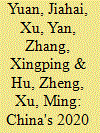

|
|
|
|
|
| Publication |
2014.
|
| Summary/Abstract |
China has proposed its 2020 clean energy target together with the climate change target of reducing CO2 intensity of the economy by 40-45% below the 2005 level. This article investigates the feasibility of these targets by testing their consistency under possible economic development scenarios. We analyse these targets from two perspectives: consistency with the overall economic growth and consistency with the international society's expectation on China's greenhouse gas (GHG) abatement responsibilities. The main findings are: under the recently announced 2020 target of gross domestic product (GDP) that is double the 2010 level, the adoption of a 15% clean energy target could result in excessive primary energy demand; and then with 40-45% GDP CO2 intensity reduction, CO2 emissions in 2020 could substantially exceed the International Energy Agency (IEA) 450 ppm scenario for China. Thus we propose a 17% clean energy target that can reconcile the domestic plan with international expectation. Our article also outlines the pathways to realise clean energy development into 2020 and proposes policy recommendations.
|
|
|
|
|
|
|
|
|
|
|
|
|
|
|
|
| 7 |
ID:
127279
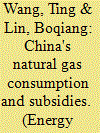

|
|
|
|
|
| Publication |
2014.
|
| Summary/Abstract |
China's natural gas consumption is growing rapidly and it has being driven by economic growth, industrialization and urbanization. In addition, the country's low-carbon development strategy, government-controlled gas price, and some other factors also contribute to the surging gas consumption. This paper studies China's natural gas consumption in residential, industrial and commercial sectors. We adopt the cointegration test and error correction model to study the relationships of explanatory factors and gas consumption of different sectors and climate factor is included into the analysis. In order to find the direction of natural gas pricing reform and establish the benchmark gas price, this paper also estimates the size of gas price subsidy by using price-gap approach. Our findings are as follows: In the long term, China's residential sector is more sensitive to price than the other two. Urbanization is an important factor promoting industrial and commercial gas consumption. Prices of other energies have an influence on natural gas consumption significantly due to the substitutability between energies. The slow-moving and unsatisfying pricing reforms on refined oil and natural gas lead to positive price elasticity of natural gas in the commercial sector, which implies that a further energy price reform is still stringent for China.
|
|
|
|
|
|
|
|
|
|
|
|
|
|
|
|
| 8 |
ID:
127295


|
|
|
|
|
| Publication |
2014.
|
| Summary/Abstract |
Sovereign Wealth Funds (SWFs) are state-owned investment funds that invest in real and financial assets. Since the global financial crisis in 2008, SWFs' investments have resulted in national security concerns of host countries because SWFs continue to expand rapidly and have become increasingly active in real-time strategic transactions. Given this background, China, which has the biggest SWF in the world, is facing severe challenges of energy resources shortages while its plan is to accomplish social and economic development goals. Energy security is a key driving force of the energy investment policy of China's SWFs. This makes the SWF investments more complicated and more politically sensitive. The combination of sovereign rights and the strategic importance of energy also makes geopolitics more complicated and brings more uncertainty to SWF investments. This article explores the relationship between energy security and energy investments of China's SWFs. It is recognised that the energy investment of SWFs must follow a sustainable path to coordinate energy security, economic growth, return on investment and national security concerns. Government policymakers are urged to balance the financial and political returns on SWFs against potential negative effects. The conclusion presents insights for policymakers, energy scholars and SWF researchers.
|
|
|
|
|
|
|
|
|
|
|
|
|
|
|
|
| 9 |
ID:
127257


|
|
|
|
|
| Publication |
2014.
|
| Summary/Abstract |
Combined Heat and Power (CHP) has been proven as a mature technology that can benefit both building owners and utility operators. As the economic and environmental benefits of CHP in urban centers gain recognition, regulations and policies have evolved to encourage their deployment. However, the question remains whether these policies are sufficient in helping to achieve the larger sustainability goals, such as the New York City-specific goal of incorporating 800 MW of distributed generation. In this paper, the current regulatory and policy environment for CHP is discussed. Then, an engineering analysis estimating the potential for CHP in NYC at the individual building and microgrid scale, considered a city block, is performed. This analysis indicates that over 800 MW of individual building CHP systems would qualify for the current incentives but many systems would need to undergo more cumbersome air permitting processes reducing the viable capacity to 360 MW. In addition microgrid CHP systems with multiple owners could contribute to meeting the goal even after considering air permits; however, these systems may incorporate many residential customers. The regulatory framework for microgrids with multiple owners and especially residential customers is particularly uncertain therefore additional policies would be needed to facilitate their development.
|
|
|
|
|
|
|
|
|
|
|
|
|
|
|
|
| 10 |
ID:
127201


|
|
|
|
|
| Publication |
2014.
|
| Summary/Abstract |
India is poised to spend over USD 5.8 billion as part of the National Smart Grid Mission aimed to alleviate India's ailing power sector as part of its 12th Five year plan (2012-2017). The federal government sponsored Restructured Accelerated Power Development and Reforms Program (R-APDRP) is also focused on building ICT capability in the state electricity boards. Presently however, there is no power sector specific cyber security mandates or policies in India. The Stuxnet, Shamoon and Anonymous incidents have shown that cyber attacks can cause significant damage and pose a risk to National Critical Infrastructure. A lack of security planning as part of designing the Smart grids can potentially leave gaping holes in the country's power sector stability. The paper highlights key cyber security threats across the entire power sector value chain-from generation, to transmission and distribution. It is aimed at building the case for power sector specific cyber security regulations based on the experience of regulators in other critical infrastructure sectors like Banking and Telecom in India and power sector regulations internationally.
|
|
|
|
|
|
|
|
|
|
|
|
|
|
|
|
| 11 |
ID:
127233


|
|
|
|
|
| Publication |
2014.
|
| Summary/Abstract |
Through a qualitative comparative case study, this investigation examined the process by which three school districts in Wisconsin, U.S.A., developed a school energy policy and complementary energy education plan. To guide the process, the researchers created an outline of recommended steps for the districts to follow. Although there were variations in the sequence and perceived ease of the steps, the Energy Task Force members involved in the process found the outline to be a supportive guide. Further analysis of the cases involved interviewing members of the Energy Task Forces to identify facilitating and obstructing factors. The study concluded that factors such as level of environmental literacy, along with aspects of the school culture and leadership, interacted to influence the successful drafting of school energy policies and education plans. In addition to introducing an outline of recommended steps that can be used by other school policy development teams interested in promoting energy efficiency, this study adds insights into the analysis of energy policy work within the context of a school setting.
|
|
|
|
|
|
|
|
|
|
|
|
|
|
|
|
| 12 |
ID:
127301


|
|
|
|
|
| Publication |
2014.
|
| Summary/Abstract |
This paper assesses the impacts on the cement, steel and oil refining sectors in Spain of the carbon prices derived from the European Emissions Trading Scheme (EU ETS), and the potential effect on these sectors of the European Union anti-leakage policy measures. The assessment is carried out by means of three engineering models developed for this purpose. Our results show a high exposure to leakage of cement in coastal regions; a smaller risk in the steel sector, and non-negligible risk of leakage for the oil refining sector when carbon allowance prices reach high levels. We also find that the risk of leakage could be better handled with other anti-leakage policies than those currently in place in the EU.
|
|
|
|
|
|
|
|
|
|
|
|
|
|
|
|
| 13 |
ID:
127234
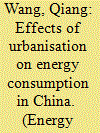

|
|
|
|
|
| Publication |
2014.
|
| Summary/Abstract |
As a key issue in China's economic development, urbanisation creates increasing pressure on energy supply and the natural environment. Thus, a better understanding of the relationship between urbanisation and energy consumption is necessary for Chinese decision makers at various levels to address energy security and sustainable economic and social development. This paper empirically investigates the effects of China's urbanisation on residential energy consumption (REC) and production energy consumption (PEC) through a time-series analysis. The results show that compared with rural areas, urbanisation slows per capita REC growth because of the economy of scale and technological advantages associated with urbanisation but has greater promotional effects on the growth of REC and the improvement of REC structure. The economic growth caused by urbanisation most significantly contributes to an increase in PEC, whereas technological advancement was found to reduce the scale of PEC (except from 2001 to 2005). Finally, the structural effect of the energy supply increased rather than decreased China's PEC, and the effect of industrial structure adjustment on PEC was found to be insignificant.
|
|
|
|
|
|
|
|
|
|
|
|
|
|
|
|
| 14 |
ID:
127291
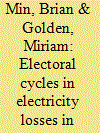

|
|
|
|
|
| Publication |
2014.
|
| Summary/Abstract |
A third of electricity in India is lost each year, where losses refer to power that is supplied but not billed. Utilizing data from the power corporation of Uttar Pradesh, India's most populous state, we study the politics of electricity losses. Examining annual data over four decades, we document that UP's electricity losses tend to increase in periods immediately prior to state assembly elections. Drawing upon geographically disaggregated data for the period 2000-09, we observe higher line losses just prior to the 2002 and 2007 state elections. Our analysis shows that the incumbent party was more likely to retain the assembly seat as line losses in the locality increased. We interpret these results as corroboration that political parties deliberately redirect electricity to flat rate and unbilled users in a context of chronically inadequate supply. Political factors appear to affect line losses in ways that technical and economic factors alone cannot explain.
|
|
|
|
|
|
|
|
|
|
|
|
|
|
|
|
| 15 |
ID:
127203


|
|
|
|
|
| Publication |
2014.
|
| Summary/Abstract |
The increases in a country's energy capacity are related to its gross domestic product (GDP). In Brazil, increases in income and the consumption of goods and services have led to an increase in the generation of solid waste (SW), which is sent to landfills as a method of treatment and final disposal. The purpose of this study was to facilitate an increase in energy generation from renewable resources, specifically from landfills via thermal biogas plants, and the research was divided into two phases. The first phase involved the assessment of the potential population size contributing to the landfill, which could result in the installation of a financially viable enterprise to generate electricity in Brazil. Next, an estimate of the costs associated with the generation and collection of solid waste in Brazil was predicted by GDP prognoses, the latter being in accordance with the National Energy Balance (Balanço Energético Nacional - BEN) plan created by the Mines and Energy Ministry of Brazil (Ministério de Minas e Energia do Brasil - MME). The net present value (NPV) and internal rate of return (IRR) of each enterprise scenario was used in the first stage to assess the plan's financial viability. In the second stage, estimation curves such as logistics, decreasing rate of growth, and logarithmic curves were used to establish relationships between the generation scenarios and the projected collection of SW and projected GDP. Thus, a range of possible landfill biogas/methane generation values and installed energy capacities were created, considering the extreme maximum and minimum values. These values were related to the energy sources from residual fuels reported by BEN. The results demonstrated that such values still represented a small percentage (0.00020% in 2010 and 0.44496-0.81042% in 2030) of the projected energy generation from residual fuels. Thus, an urgent need was identified to formulate policies that would encourage landfills as a source of renewable energy, broadening the number of financially viable initiatives for energy generation from landfill biogas for populations of fewer than 200,000 inhabitants.
|
|
|
|
|
|
|
|
|
|
|
|
|
|
|
|
| 16 |
ID:
127206


|
|
|
|
|
| Publication |
2014.
|
| Summary/Abstract |
Emergent business models seek to take advantage of new market mechanisms driven by technological changes, particularly those related to the production and delivery of clean or sustainable energy. Such business models often function at the intersection of various industries, with global views, and the resulting systems have distinct social, political, environmental, economic, technological, and business dimensions. Such holistic systems are not only difficult to develop but also require support from a broad range of actors with effective regulations and policies in place, such that the firm functions within a framework that integrates various factors. This study substantiates such a framework by detailing the nascent algae-based bio-fuel industry that caters to the aviation sector while arguing that businesses in the energy industry can emerge as a next-practice platform that drive a sixth wave of innovation. The framework begins with three basic enablers, innovation, flexibility, and sustainability, and explains how value from renewable energy technologies can be created and captured sustainably and innovatively with new market mechanisms implemented by firms with green business models.
|
|
|
|
|
|
|
|
|
|
|
|
|
|
|
|
| 17 |
ID:
127244


|
|
|
|
|
| Publication |
2014.
|
| Summary/Abstract |
There is an increasing political pressure on the city planning to create more energy efficient city plans. Not only do the city plans have to enable and promote energy efficient solutions, but it also needs to be clearly assessed how energy efficient the plans are. City planners often have no or poor know how about energy efficiency and building technologies which makes it difficult for them to answer to this need without new guidelines and tools. An easy to use tool for the assessment of the energy efficiency of detailed city plans was developed. The aim of the tool is for city planners to easily be able to assess the energy efficiency of the proposed detailed city plan and to be able to compare the impacts of changes in the plan. The tool is designed to be used with no in-depth knowledge about energy or building technology. With a wide use of the tool many missed opportunities for improving energy efficiency can be avoided. It will provide better opportunities for sustainable solutions leading to less harmful environmental impact and reduced emissions.
|
|
|
|
|
|
|
|
|
|
|
|
|
|
|
|
| 18 |
ID:
127232


|
|
|
|
|
| Publication |
2014.
|
| Summary/Abstract |
Use of shallow geothermal energy, in terms of ground coupled heat pumps (GCHP) for heating and cooling purposes, is an environmentally-friendly and cost-effective alternative with potential to replace fossil fuels and help mitigate global warming. Focusing on the recent results of the GEO.POWER project, this paper aims at examining the energy performance strategies and the future regional and national financial instruments for large scale introduction of geothermal energy and GCHP systems in both residential and industrial buildings.
After a transferability assessment to evaluate the reproducibility of some outstanding examples of systems currently existing in Europe for the utilisation of shallow geothermal energy, a set of regulatory, economic and technical actions is proposed to encourage the GCHP market development and support geothermal energy investments in the frame of the existing European normative platforms. This analysis shows that many European markets are changing from a new GCHP market to growth market. However some interventions are still required, such as incentives, regulatory framework, certification schemes and training activities in order to accelerate the market uptake and achieve the main European energy and climate targets.
|
|
|
|
|
|
|
|
|
|
|
|
|
|
|
|
| 19 |
ID:
127305


|
|
|
|
|
| Publication |
2014.
|
| Summary/Abstract |
The emergence of biofuel as a renewable energy source offers opportunities for significant climate change mitigation and greater energy independence to many countries. At the same time, biofuel represents the possibility of substitution between energy and food. For developing countries like India, which imports over 75% of its crude oil, fossil fuels pose two risks-global warming pollution and long-term risk that oil prices will undermine real living standards. This paper examines India's options for managing energy price risk in three ways: biofuel development, energy efficiency promotion, and food productivity improvements. Our salient results suggest that biodiesel shows promise as a transport fuel substitute that can be produced in ways that fully utilize marginal agricultural resources and hence promote rural livelihoods. First-generation bioethanol, by contrast, appears to have a limited ability to offset the impacts of oil price hikes. Combining the biodiesel expansion policy with energy efficiency improvements and food productivity increases proved to be a more effective strategy to enhance both energy and food security, help mitigate climate change, and cushion the economy against oil price shocks.
|
|
|
|
|
|
|
|
|
|
|
|
|
|
|
|
| 20 |
ID:
127304


|
|
|
|
|
| Publication |
2014.
|
| Summary/Abstract |
How would a low-carbon energy transformation affect energy security? This paper proposes a framework to evaluate energy security under long-term energy scenarios generated by integrated assessment models. Energy security is defined as low vulnerability of vital energy systems, delineated along geographic and sectoral boundaries. The proposed framework considers vulnerability as a combination of risks associated with inter-regional energy trade and resilience reflected in energy intensity and diversity of energy sources and technologies. We apply this framework to 43 scenarios generated by the MESSAGE model as part of the Global Energy Assessment, including one baseline scenario and 42 'low-carbon' scenarios where the global mean temperature increase is limited to 2°C over the pre-industrial level. By and large, low-carbon scenarios are associated with lower energy trade and higher diversity of energy options, especially in the transport sector. A few risks do emerge under low-carbon scenarios in the latter half of the century. They include potentially high trade in natural gas and hydrogen and low diversity of electricity sources. Trade is typically lower in scenarios which emphasize demand-side policies as well as non-tradable energy sources (nuclear and renewables) while diversity is higher in scenarios which limit the penetration of intermittent renewables.
|
|
|
|
|
|
|
|
|
|
|
|
|
|
|
|
|
|
|
|
|